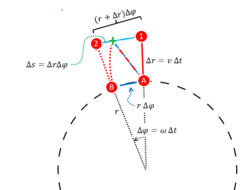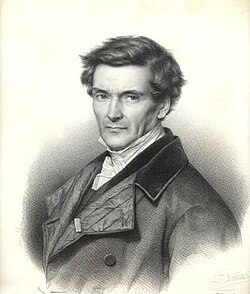Parabolic dish ellipse oscill
(source Description: The animation shows a rotating parabolic dish. On the left the motion as seen from an inertial point of view, on the right the motion as seen from a co-rotating point of view. The dish is solid and it has exactly the same shape as a fluid rotating at that angular velocity has. The dark dot is a puck that can slide over the surface with very little friction. The parabolic dish is very shallow: the up-down motion of the puck is very small compared to the motion parallel to the dish's surface.
Since the force towards the center is proportional to the distance to the center, the shape of the trajectory of the puck is an ellipse. This ellipse can be thought of as two perpendicular harmonic oscillations. As seen from a rotating point of view only the eccentricity of the ellipse-shaped trajectory is visible.
The eccentricity can be thought of as a combination of two oscillations: an oscillation of the angular velocity and an oscillation in the distance to the center of rotation.
This 256x128 pix animation combines the perspectives of the following two 256x256 pix animations: Image:Parabolic_dish_motion_ellipse.gif and Image:Parabolic_dish_inert_oscill.gif)Relevante Bilder
Relevante Artikel
CorioliskraftDie Corioliskraft ist eine der drei Trägheitskräfte der klassischen Mechanik, die in einem rotierenden Bezugssystem auftreten. Die Auswirkung der Corioliskraft in rotierenden Systemen wird auch als Corioliseffekt bezeichnet. Die Corioliskraft ist eine Scheinkraft und als Teil des Trägheitswiderstands in Bezug auf die äußere Rotationsbewegung zu verstehen. Sie wurde erstmals 1775 von Pierre-Simon Laplace korrekt hergeleitet. Sie wird aber nach Gaspard Gustave de Coriolis benannt, der sie in einer 1835 erschienenen Publikation ausführlich behandelte. .. weiterlesen























